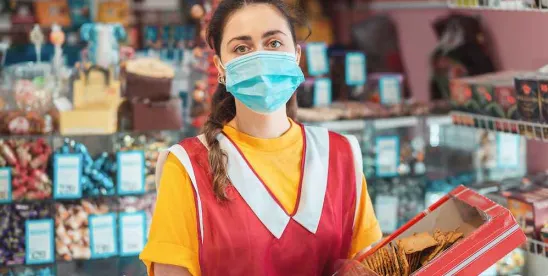As Congress continues to discuss the next coronavirus (COVID-19) stimulus package, one bill in particular has become a flash point in the negotiations: the SAFE TO WORK Act, which would provide far-reaching liability protection to businesses for injuries related to COVID-19. The proposed version of the SAFE TO WORK Act bill1 would provide a significant liability shield to a number of businesses for anticipated COVID-19-related lawsuits. Generally, the Bill would provide an exclusive, limited remedy for those who allege a COVID-19-related injury through exposure at a business, during one’s employment,2 or while receiving medical care. The Bill would also limit certain product liability for drugs or medical devices. This alert describes the proposed version of the Bill with regard to businesses and medical care.
GENERAL LIABILITY SHIELD FOR EXPOSURE AT A BUSINESS
At the heart of the Bill is general liability protection for businesses against COVID-19 exposure claims. The Bill, as currently drafted, would make it significantly more difficult for plaintiffs to pursue lawsuits against businesses for injuries from alleged COVID-19 exposures. The Bill creates an exclusive remedy (with limited exceptions) for COVID-19 exposure claims related to injuries occurring between 1 December 2019 and 1 October 2020 or the end of the public emergency declaration, whichever is later. To succeed on a claim, a plaintiff would need to prove, with clear and convincing evidence, that (1) a business did not make reasonable efforts to comply with applicable governmental standards and guidance, (2) the business engaged in gross negligence or willful misconduct that caused an exposure to COVID-19, and (3) that exposure caused the plaintiff’s injury (which includes physical, mental, and emotional injuries). Any claim must be brought within one year of the alleged exposure.
The Bill’s level of proof, “clear and convincing evidence,” is higher than that for most claims arising from injuries, which usually require only a “preponderance of evidence” standard. In essence, this would make it harder to prove a viable exposure claim. In addition, the one-year statute-of-limitations period (meaning you need to bring a claim within one year of suffering an injury) is shorter than most typical statute-of-limitations periods, which are usually two to four years for personal injury claims. The need to show the causal link is significant, given the potential for COVID-19 exposure through a variety of sources. The Bill also would establish a rebuttable presumption that a business made reasonable efforts to comply with applicable standards and guidance if it maintained a written COVID-19 mitigation policy.
EXCLUSIVE REMEDY FOR MEDICAL LIABILITY CLAIMS
The Bill, as currently drafted, would also create an exclusive remedy (with limited exceptions) for COVID-19-related medical liability claims.4 To succeed on such a claim, a plaintiff would need to prove, with clear and convincing evidence, that (1) the health care provider engaged in gross negligence or willful misconduct and (2) the provider’s conduct caused the alleged harm. A medical liability claim would typically need to be brought within one year. The Bill would not only apply to practitioners but also supervisors, administrators, and volunteers. The Bill’s definition of “health care provider” includes entities authorized to provide care in a home or in a “community-based residential setting under the State Medicaid program or a waiver of that program.” This language may be expansive enough to include nursing homes in some circumstances.
PROCEDURAL RULES UNDER THE BILL
Whether a plaintiff files suit in federal or state court, the Bill would impose certain procedural rules that differ from typical civil actions.5 As with other portions of the Bill, these rules would significantly benefit businesses responding to COVID-19-related lawsuits.
Heightened Pleading Standard
Any lawsuit brought for an exposure or medical liability claim must be pled with particularity, which is a more stringent pleading standard than is typical. Further, the lawsuit must also set forth all places or persons visited by the plaintiff during the 14-day period before the onset of the plaintiff’s first symptoms. The plaintiff must allege the factual basis for his or her belief that it was the defendant who caused the alleged injury, as well as the factual basis for why his or her injury was not caused by other potential exposures. If the plaintiff is seeking monetary damages, the plaintiff must file a separate statement with the lawsuit that specifies the nature and amount of each element of damages and the factual basis for the damages calculation. These two provisions would make it more difficult for a plaintiff to actually file a lawsuit because they would be required to present much more information up front and validate their claims.
Medical Records
A plaintiff’s lawsuit must be accompanied by an affidavit of a physician or medical expert who did not treat the plaintiff. The medical affidavit must explain the basis for the expert’s belief that that the plaintiff suffered the harm and include certified medical records that document the injury. Accordingly, the Bill would require plaintiffs to retain an expert before filing a lawsuit.
Limitation on Discovery
The Bill would limit discovery in an action to matters directly related to material issues contested in the action. The court may compel discovery responses only if the information is needed to prove or defend a material issue and the likely benefits of a response outweigh the burdens of responding. This change would decrease the costs of litigation, which often require timely and expensive discovery between the parties.
Limitations on Damages and Liability
Under the Bill, defendants found liable for an exposure or medical liability claim are only responsible for their proportionate share of a plaintiff’s damages, unless the defendant intentionally injured the plaintiff or committed fraud. Additionally, under the Bill, the damages a plaintiff can recover would typically be limited to economic losses incurred as a result of the plaintiff’s injury. If a defendant conducted willful misconduct, noneconomic and punitive damages may be recoverable. Any damages rewarded, moreover, will be reduced by compensation received from other sources, such as insurance. These provisions would materially reduce the damages a defendant would have to pay if they are found liable.
Class Actions
The Bill would require class members to opt in to class actions—this differs from typical class actions that usually include class members unless they opt out. In the event of a class action, courts will be required to issue a notice to each member of the class that describes the nature of the case, explains the fee arrangements with the class counsel, and provides the description of any financing agreement if costs are being financed. These procedural changes would limit the usefulness of class action litigation and decrease the likelihood of obtaining outside litigation financing for such a case.
MERITLESS CLAIMS
The Bill would deter meritless claims and demands by creating a private cause of action allowing businesses to seek damages arising from demand letters based on meritless claims.6 Available damages would include costs incurred in responding to the demand, reasonable attorney’s fees, and potentially punitive damages in some cases.
PRODUCT LIABILITY PROTECTIONS
Finally, the Bill further amends the liability protections of the Public Health Service Act, which provides immunity from claims for injuries caused by drugs or other products administered as a “countermeasure” to a public emergency.7 The Bill expands the Public Health Service Act’s definition of a “countermeasure” to include drugs, devices, or biological products (including vaccines) that meet applicable U.S. Food and Drug Administration requirements and are the subject of a notice of enforcement discretion.8 In other words, if the federal government notifies the public that it will not bring enforcement actions against particular uses of certain drugs or devices that might otherwise be impermissible, then those uses would benefit from the immunity protection of the Public Health Service Act, and plaintiffs would be unable to bring claims for injuries caused by those uses.
CONCLUSION
If passed in its current form (which seems unlikely), the Bill would provide significant protections to businesses by making COVID-19-related litigation considerably more difficult for plaintiffs—with the potential effect of significantly reducing the amount of litigation regarding COVID-19-related harm suffered by individuals. The Senate will be negotiating the Bill as part of the next stimulus package when it returns to session on 8 September 2020. We are continually monitoring the status of the Bill and will provide updates to this alert as the status or scope of the Bill changes.
Footnotes
1 SAFE TO WORK Act, S. 4317, 116th Cong. (2019-2020) [hereinafter Bill].
2 Employment-related issues associated with the Bill are not addressed in this alert. To summarize, the Bill would also provide employers with liability protection under certain employment laws if various requirements set forth in the Bill are met.
3 Bill §§ 121–122.
4 Bill §§ 141–142.
5 Bill §§ 162–163.
6 Bill § 164.
7 42 U.S.C. § 247d-6d.
8 Bill § 201.




 />i
/>i

